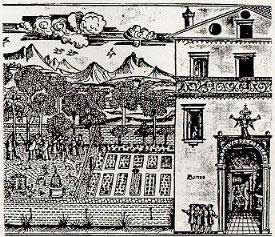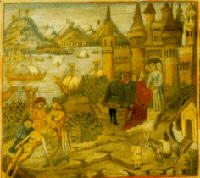The Salerno School of Medicine
In the 9th century, during the Norman times, a School of Medicine was founded in Salerno thus being the most ancient School of Medicine of the West.
The origins of the Schola Medica Salernitana lay in legend, but in it we can recognise the mix of cultures and the lively scientific and cultural environment of Salerno during the Norman period: according to the legend the school was founded by four physicians, the Jew Elinus, the Arab Adela, the Greek Pontus and the Latin Salerno, thus precisely showing the union of different cultures in the newfound science of medicine.

The fame of the school rapidly grew in Europe, in fact many kings and princes came to Salerno to ask for the cures of the local physicians.
An oral tradition, very close to a legend, tells that Robert Duke of Normandy, on his way back home from the First Crusade stopped in Salerno in 1103: a poisoned arrow had caused to him a serious wound in his right arm and the spreading of the infection had to be urgently blocked. The physicians of the school said that someone had to sacrifice and die to suck the blood from the wound. Robert didn’t want anyone to die for him, but during the night his wife Sibilla sucked the blood in his sleep, thus dieing and saving her husband’s life.

At the same time in England king William, Robert’s brother, died: Robert had to leave to occupy the throne but before his departure he asked the physicians of Salerno’s School a vademecum, a sort of handbook of the basic principles of the science of medicine. That’s why the most famous book of Salerno’s School of Medicine, the “Regimen Sanitatis Salernitanum" was dedicated to the King of England. The scene of Robert (in red) saying goodbye to the physicians while his wife is being buried in the left corner of the miniature is represented in the famous Canon of Avicenna.
The School of Medicine distinguished itself for being based only on practical, scientific and autonomous notions, was a centre for botanical studies and also for philosophy, thus being one of the centre of the scientific renaissance. The practical vocation of the school is the reason why in the city there were many hospitals, especially in monasteries, while the physicians were mainly lay and among them there were also women, the most famous of whom was Trotula de Ruggiero, the author of a famous treaty about gynaecology. Also treaties about ophthalmology, surgery, urology and other branches were written.
This is the way Salerno gained the title of “hippocratica civitas”, city of the Greek Hippocras, the most famous and most ancient physician we can remember.
The school flourished for centuries but started its slow decay during the XIV century, when the centre of Europe wasn’t anymore the Mediterranean Sea, and was ultimately closed with a decree of Gioacchino Murat, the king of Naples and Napoleon’s brother-in-law, in 1811.